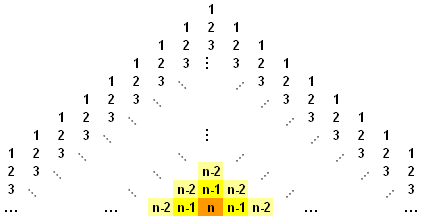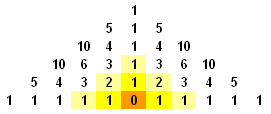Lost in space
Problem
There are three ways to enter the triangular array of numbers in the diagram below, starting with 1, and counting from 1 -2 in order, finishing with the two in the bottom row.
How many ways are there to count 1 - 2 - 3 in the following array?
And 1 - 2- 3 - 4 on this?
Can you generalize?
Can you explain what you find?
Getting Started
To help explain it is worth considering the journey from the bottom up.
Student Solutions
Derek (no school given) offered the following insights into this problem: - and nicely explained too - thank you Derek.
From observation, we compile the table below:
| n-row pyramid | Ways to count 1-2-3-... |
| 1 | 1 |
| 2 | 3 |
| 3 | 7 |
| 4 | 15 |
| ... | ... |
The pattern can be deduced by considering route backwards, i.e. from n back to 1. The general n-row pyramid is shown below:

Starting at the orange square, we assert that there are 0 routes leading to the final square:

1 step earlier, at the bright yellow squares, there is 1 route leading to the final square:

1 step earlier, at the light yellow squares, the situation becomes slightly different.The top, left and right squares all have 1 route leading to the final square. However, the middle squares have 2 routes as they each connect to 2 bright yellow squares (each of which are routes leading to the final square):

1 step earlier, the top, left and right squares all have 1 route whilst the middle squares have 3 routes as they each connect to 2 light yellow squares, bearing a total of 3 routes. We repeat this reasoning and get the following pattern:

It is clear that these are the binomial coefficients. 2 of Pascal's triangles have been arranged together and the numbers along the two slanted edges represent how many ways to count 1-2-3-...-n. For example, in the diagram of the 6-row pyramid above, we see that there are 1+5+10+10+5+1+5+10+10+5+1 = 63 ways to count 1-2-3-4-5-6.
We further notice that 1, 5, 10, 10, 5, 1 are the binomial coefficients $5 \choose {k}$ $,k = 1, 2, 3, \cdots, 5 $. We generalise by claiming that the number of ways of counting $1-2-3-...-n$ is twice (because there are two Pascal's triangles) the sum of all the binomial coefficients of the $n-1^{th}$ row minus 1 (because of the overlapped 1 down the central column) which can be written as $2\sum_{k=0}^{n-1}$ ${n-1}\choose{k}$ $ - 1$.
Editor's comment: at this point it may be worth mentioniing that the sum of the binomial coefficients are powers of 2. Why?
Chen of the Chinese High School took a slightly different approach (similar to the one offered by Andrei of Tudor Vianu National College):
Teachers' Resources
The idea of routes through triangular mazes can be adapted for a range of similar problems.
Is it possible to create different arrangements of numbers to give different families of solutions?
